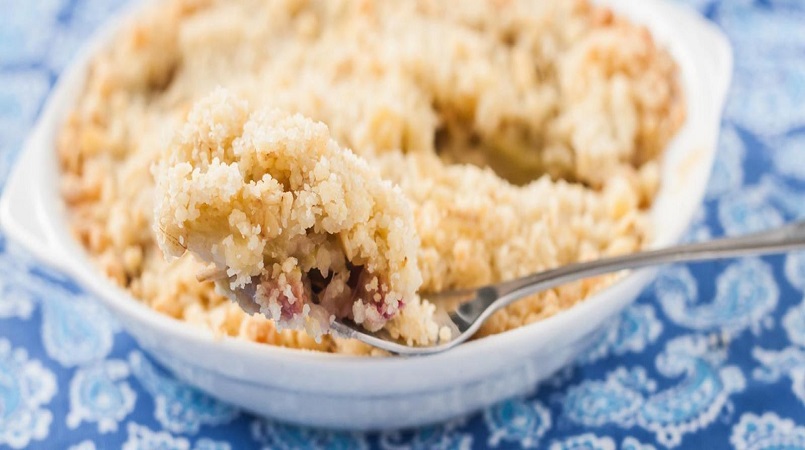
We've all suffered from the occasional overindulgence, and most of us likely have a few dodgy oysters or shrimp canapes ruefully enshrined in our memory.
But by and large, we eat pretty safely these days. While some thrill-seekers search for fugu – the Japanese pufferfish, which is laden with the nerve poison tetradotoxin – and risk becoming one of its surprisingly numerous victims, most of us prefer a diet that is a good deal more innocuous. For all that, you might be surprised to learn that some familiar foods are next-door neighbours to things which can be very harmful to our health.
Rhubarb pies and jams are favourite seasonal delights. What's summer without a pan of tart red stems simmering on the stove, ready to be decanted into a waiting crust? The lush plants, with their spreading green leaves, are traditional adornments to the backyard vegetable garden. However, while the stems are edible, the leaves are extremely dangerous.
In 1919, a doctor in Helena, Montana, wrote to the Journal of the American Medical Association concerning the disturbing case of a young wife who was pale, exhausted, and vomiting when he arrived. She had apparently been pregnant – he found “the complete products of conception of about six weeks’ development, discharged into the bed clothes” – but the placenta was bloodless, and what blood there was would not coagulate. She died a few hours later, bleeding from the nose.
The night before, she'd made rhubarb stems and leaves for supper, and had eaten most of the leaves herself, while her husband had only a little. He was weak and dizzy, but did not die. The journal editors wrote back that the doctor's hunch – that she had been poisoned by the rhubarb leaves, probably by a substance called oxalic acid – was likely correct.
“A number of deaths from the use of the leaves have been reported,” they wrote. “During the war the use of the leaves as a food substitute was recommended in England; when the danger of fatal poisoning became apparent (owing to several deaths) warnings against the use of the leaves were issued.” Oxalic acid, as it happens, is present in both leaves and stems but in much higher quantities in the leaves. It causes kidney failure, and while you'd have to eat a hearty helping of the leaves to die, better just to avoid them altogether. (Rhubarb even appears in the Poison Garden at Alnwick Gardens in Northumberland, where a number of deadly and dangerous plants are cultivated in a macabre tourist attraction.)
Another peculiar case is that of the humble potato – which is not, in the usual course of things, anything to be concerned about. When it's stored in sunlight, however, chemical reactions at its surface turn it green with chlorophyll as it prepares to sprout. At the same time, a substance called solanine is also produced. It is named after the deadly nightshade (Solanum nigrum); potatoes happen to be a cousin to nightshade, as are tomatoes and eggplants.
Solanine-rich green potatoes, while not in the same class as this famous plant, can produce some unpleasant effects in those who eat them. In the autumn of 1978, 78 schoolboys in South London came down with diarrhea, vomiting, and other symptoms after eating boiled potatoes. Later investigation showed that the potatoes they'd eaten had been left in the school stores since summer, and an analysis of the peels revealed them to be packed with solanine.
All eventually recovered, “though some were confused and hallucinated for several days”, records a small British Medical Journal story on the incident from the following year, which noted that there had been reports of deaths from eating green potatoes in the past, though mainly in malnourished people who hadn't had medical help quick enough.
Solanine appears to interfere with the nervous system, impairing the normal functioning of ion channels in cells. This may explain why some of the poisoned boys showed strange twitches before they recovered. (Potato leaves and stems, incidentally, are to be avoided as entrees – solanine dwells there, too)
Elderberry wine, in turn, is a fine, romantic thing to drink. Just make sure, if you're making it yourself, that the romance doesn't extend to including any of the plant's leaves in your tincture. Almost every part of the elderberry tree contains hydrogen cyanide or its precursors, including the leaves and unripe berries. While cooking the berries destroys the offending molecules, rendering elderberry jams perfectly safe, consuming them without this precaution sometimes leads to unhappy results.
In 1983, the CDC's Morbidity and Mortality Weekly Report shows, eight people were helicoptered to a Monterey, California, hospital. They had gone on a remote “religious/philosophical” retreat with 17 others, and the day after they arrived, someone had brought out a juice made from wild elderberries gathered nearby. The berries had been crushed and mixed with apple juice, water, and sugar, but not apparently heated. Within 15 minutes of the juice's arrival, people began to vomit. The person who drank the most juice spent the night in the hospital. In the end, luckily, all recovered.
As you sit down at the table, you can be grateful to modern food safety precautions for eliminating most of the frightening guesswork in avoiding poisons. That bite of potatoes, or slab of rhubarb or elderberry pie, should be delicious, not deadly, if everything has been stored and cooked correctly.
But you may feel a frisson of excitement – perhaps something like what fugu eaters must feel – when you think of the dangers lurking nearby.
